Reason’s Ghosts: The Settling & Unsettling of The Plains
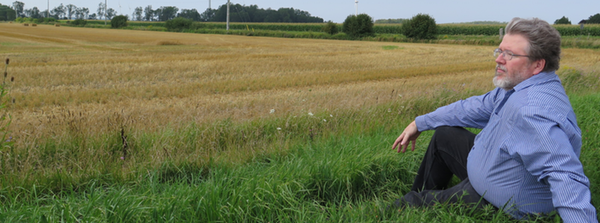
“On the 18th of December, 1635, François Derré, sieur de Gand, Commissary-General of the Hundred Associates (the trading and colonization company of New France), went ‘to the Cabins of the Savages’ to give new orders concerning the prohibition of the traffic in liquor. Pointedly, he referred to deaths among the Indians caused by abuse of alcohol. His listeners, we are told, generally approved his measures, though some wondered why alcohol had been allowed into their country at all. One of them, however, disputed Gand’s assertions: ‘No,’ he said, ‘it is not these drinks that take away our lives, but your writings; for since you have described our country, our rivers, our lands, and our woods, we are all dying, which did not happen until you came here.’”—By William Ramp
Small Things Recollected
By William Ramp
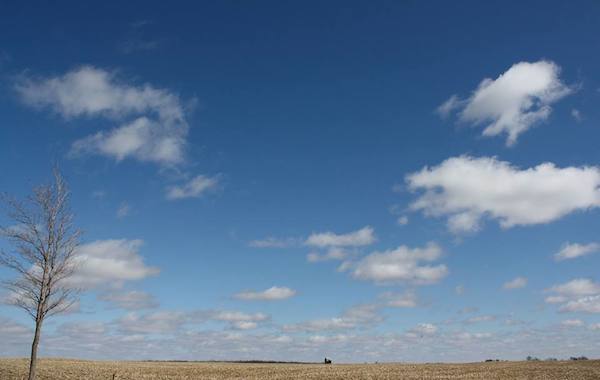
LETHBRIDGE Alberta, Canada—(Weekly Hubris)—8/25/2014—Last month, I wrote about the thousands of years of cultural continuity which still bind past, present and future together for the first peoples of the North American plains, despite all the cultural and other damage visited on them over the past 200 years.
This month, I will turn over that first thin shard of time during which Europeans pushed into the North American interior, looking at the light it casts, the figures it refracts, and the shadows it leaves.
On the 18th of December, 1635, François Derré, sieur de Gand, Commissary-General of the Hundred Associates (the trading and colonization company of New France), went “to the Cabins of the Savages” to give new orders concerning the prohibition of the traffic in liquor. Pointedly, he referred to deaths among the Indians caused by abuse of alcohol. His listeners, we are told, generally approved his measures, though some wondered why alcohol had been allowed into their country at all. One of them, however, disputed Gand’s assertions: “No,” he said, “it is not these drinks that take away our lives, but your writings; for since you have described our country, our rivers, our lands, and our woods, we are all dying, which did not happen until you came here.”
Jean de Brebeuf, Jesuit missionary and future martyr, described the response of the French to this statement: “We began to laugh upon hearing these new causes of their maladies. I told them that we described the whole world,—that we described our own country, that of the Hurons, of the Hiroquois, in short, the whole earth; and yet they did not die elsewhere as they did in their country. It must be, then, that their deaths arose from other causes. They agreed to this.” (The Jesuit Relations and Allied Documents, Vol. IX. [Québec, 1636], 196-200)
Here, in the Jesuit’s account, we hear another voice besides that of the Christian missionary; that of a precursor to the secular rationalism of the Enlightenment, trained in the rigorous argumentation of his Order. For Brébeuf, logic had defeated superstition. With a few centuries of hindsight, we might ask again about the apparent victors—and loser—of this contest.
Carlo Ginzburg, writes, “Today, three and a half centuries later, we can admire the clearheadedness of the anonymous native and agree with his assessment. The geographical writings of the Jesuits opened the way to the European colonial conquests: they were a first step. The immoderate consumption of the alcoholic beverages brought by the Europeans was only an aspect of the disintegration of native culture caused by colonization.” (Ginzburg, Threads and Traces: True False Fictive, University of California Press, 2012, 86-87).
I might press the point a little further.
Could it be said that the lone dissenting Indian was speaking of something that his Jesuit sparring-partner had lost: a world in which words had substance and power of their own, in which they were not mere windows on the real, but communicated with and acted on the substances they named, and each other? Could it be that the dissenter knew that words made worlds in a way that Brébeuf did not? Was there some new and potentially deathly power in the classificatory language of the new rationalism; in the relentless logic by which Descartes, a decade or so later, would destroy received certainty, to build it up and reason it out again, Throne of God included, from the formula, cogito ergo sum [“I think therefore I am]?
But let us not read back into history a just-so story of the simple and inevitable triumph of European rationalism.
On March 28, 1670, three-and-a-half decades after Brébeuf and Gand’s laughing victory in debate, a party including Sulpician priests, François Dollier de Casson and René de Bréhant de Galinée arrived at the eastern side of (the now prosaically-named) Big Creek, a short distance above the north shore of Lake Erie.
There, they encountered a nocturnal mystery: “We slept that night on the bank of this river, about two leagues from its mouth, and it was at this place that we heard towards the east voices that seemed to us to be of men calling to each other. We ran to the river bank to see if it was not our men looking for us, and at the same time we heard the same voices on the south side. We turned our heads in that direction, but at last were undeceived, hearing them at the same time towards the west, which gave us to understand that it was the phenomenon commonly called the hunting of Arthur [la chasse artus]. I have never heard it, nor have any of those who were of our company, which was the reason we were deceived by it.” (Ontario Historical Society, Papers and Records, Vol. IV: Exploration of the Great Lakes by Dollier de Casson and Bréhant de Galinée, Part I, 1903)
The mystery is termed a mere deception and is mentioned only in passing; just a curiosity. But the words used to name it had roots deep in European mythology; la chasse artus was one of several terms used to name a company of spectral hunters, lost souls doomed to traverse the earth in pursuit of game they would never possess. This was soon to take North American form in the chasse-galerie, the haunted canoe of stories told and retold by the fur traders.
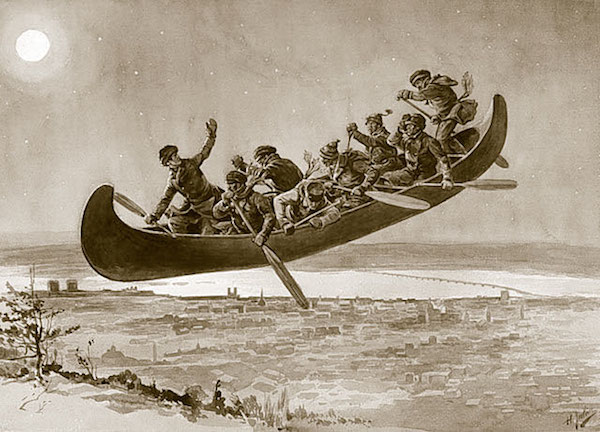
Later arrivals, too, would bring with them strange tales of midnight journeys, hidden secrets and hauntings.
In the “burned-over district” of northern New York State, after the War of 1812, fervent theologies spread alongside tales of buried treasure and scrying-stones; out of this hothouse came a prophet, Joseph Smith, who founded the first major North American religion to arise within the settler world.
Myth and reason, if unequally-yoked, both spread with settlement.
According to Sharon Butala, the use of old European imagery to understand the North American landscape and its inhabitants continues to this day, even if it is often unacknowledged. The being known in Canada as Sasquatch and in the US as Bigfoot, she says, is really two. The hairy hominid that cryptozoologists attempt to capture on lens has a typological heritage reaching back to European “wild men” and the ubiquitous medieval Green Man. This being, Butala suggests, is quite different from the ones whose stories are told in Amerindian cultures (Sharon Butala, Wild Stone Heart: An Apprentice in the Fields, HarperCollins, 2000).
The first European settlements on the broad interior plains of North America were French. By the mid-18th century, an arc of scattered trading fortifications and riverside farms known as Pays des Illinois reached along the large rivers of the interior, from the Great Lakes to the Gulf, through Michigan, Wisconsin, Minnesota, Illinois, Indiana, and Missouri. From these, a few souls walked or rode to—and beyond—the edge of the high country.
Traces of this French presence in the interior now populate primarily archived documents. Bellin’s 1764 map of Detroit displays an intriguing mix of traditional, narrow riverside lots (on what is now the Canadian side) and a right-angled grid. Physical echoes of that presence are few; often barely visible now, aside from archaeological sites and reconstructions. One can still trace them in the fencing of property lines along one or two stretches of the Detroit River. The human progeny of an intermingling between the French (and, to the north, Highland Scots) with the first inhabitants of the Plains, is more assertively alive. The Métis, as I mentioned last month, are now officially designated in Canada as a First Nation, and a cultural, political and economic presence to be reckoned with.
However, for latter-day generations of Americans, the dreamscape of the Great Plains was shaped by developments which swept away New France and the Pays. In the US, these included the Louisiana Purchase, the bursting of the great demographic dam of the Appalachians, the wagon-train of the Oregon and Santa Fe trails, the disappearance of the buffalo, and the tragic Indian wars. In Canada, the Red River settlement and the building of the transcontinental railway are similar markers (http://arts.nationalpost.com/2010/10/08/lightfoot/).
The rush to settle and transform the plains into the breadbasket of the Americas pushed an older ranching society and a number of Indian nations into redoubts of foothills, desert and mountains. The broad shoulders of the grasslands were clothed in an abundance of wheat and corn. The new European peoples of the Plains, a legion of diverse nationalities, were spot-welded together by aspiration and liberation. An ancestor of mine described his ambition modestly in June, 1834 as rising “no higher, but to be free from rent & taxes which takes all here that we can gather or scrap [sic] together.”
What that aim lacked in height, it made up for in the power of multiplication.
The transformation of the old Europe of nobility and peasantry into new property regimes populated by landlords interested in commercial gain, and leasehold or tenant farmers seeking productive advantage, set in motion a technological revolution in tillage and fertilization that made millions surplus to production.
This cold economic transition bewildered many, but pushed them off regardless to urban centers and new worlds, in quest of new modes of survival and ways of self-making. Many became wage workers in the factories of Manchester, Sheffield, Liège, and the Ruhr, or miners in Silesia or Northumbria. Others crossed the seas to North America, and many of those, as the 19th century wore on, traveled west by rail. Landlord-free tenure, and escape from past and prejudice drew those of many nations.
The prospect of becoming little lairds of their own steadings brought my Scots ancestors to a slim tongue of flat agricultural land in southwestern Ontario. Others fled starvation or sought physical safety and freedom from endemic violence. All found, in the center of the North American continent, a society in which work and money meant much and birth little, where one could choose to settle amongst one’s own, or bury one’s past, inherited status, even one’s name, forever.
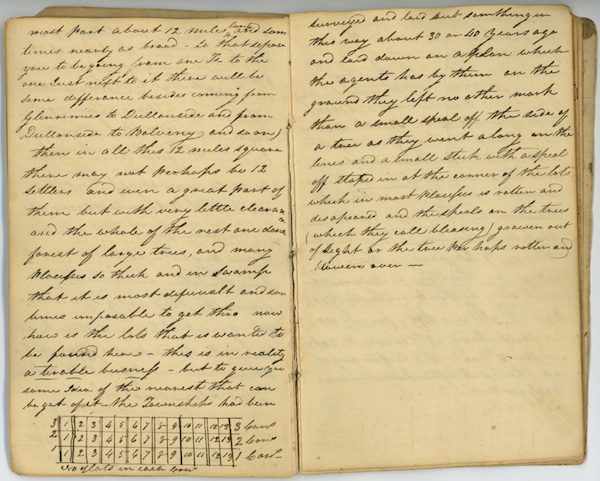
Such aspirations opened a channel by which the United States played an unanticipated role in the establishment of Canadian democracy. Two rebellions following the bank panics of 1837 showed that Canadians could fight for democratic governance, but a quieter movement did more. Faced by a colonial elite intent on reproducing in Canada a squirearchy of loyal tenants and servants bound to an established church, many would-be settlers simply melted away across the Detroit or Niagara rivers and into the US Midwest, leaving gentlemen-politicians to resign themselves to less-restrictive paths of development.
These demographic transitions were closely preceded by more quiet and focused work.
Jean de Brebeuf’s “describing” of the lands the settlers poured into became, in the 19th century, a massive exercise in practical inscribing. Surveyors sighted, measured, pounded stakes, and cut blazes; legal documents were written up, stored, and disputed; the land itself was ruled and scarified in terms of a new geometry of road and railway rights-of-way, ranges, concessions, sections, lot-lines, and fences.
And all of these were set within the stern parameters of two overarching systems of measurement: one of longitude and latitude, and another of economic conveyance and market pricing. These defined but also released the forces which birthed a new North America.
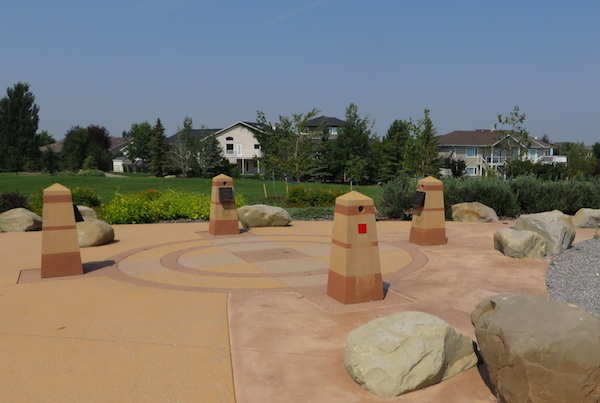
For almost a century, the US Midwest became, in dream and reality, an exultant center of the national psyche. As Carl Sandburg wrote, in “Chicago” (1914), it was broken and remade,
Under the terrible burden of destiny laughing as a young
man laughs,
Laughing even as an ignorant fighter laughs who has
never lost a battle,
Bragging and laughing that under his wrist is the pulse.
and under his ribs the heart of the people,
Laughing!
The pragmatic Midwest of agricultural enterprise and the dignity of labor, unfazed by pretension or ancestry, dedicated to freedom and democracy, was a kingdom ruled by Calculation, Enterprise and Property. Its bywords were prices, production, effort, efficiency and transportation.
An ancient webbing of trails, along with sacred places, campgrounds and riverside settlements, met death by re-inscription.
New parametric grids bespoke rationality, purpose and governance-by-quantification. Arrow-straight roads made only grudging concessions to the alignment of rivers, hills and bogs, now seen as mere obstacles in the way of the shortest distance point-to-point.
I discovered how habituated to these roads I was on a trip through Scotland. After a couple of hours of highway driving, my arms and shoulders ached from constant navigation of turns—and from the expectation, which I could not banish, that surely, around the next bend, the road must run straight! It never did.
But freedom and straightforwardness demanded a price, and the grid defined that price.
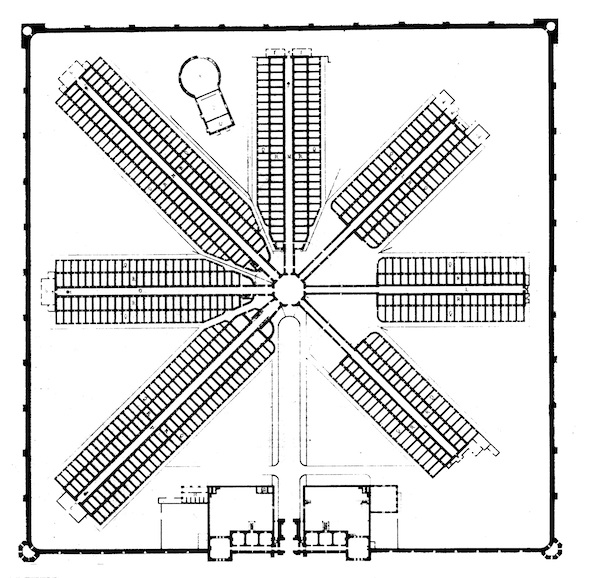
Working one day on a lecture about the rise of the new penitentiary systems of the 19th century, I looked over plans for some of these reformed prisons, which also served as models for later hospital designs. In both, long, straight hallways, often radiating from a central hub, gave access to ranges of individual cells on both sides.
Thinking about that connection led me down another avenue: the evolution of the modern hallway in domestic housing. The hall was originally a gathering place, a usage that survives in the term “community hall.” The hall-way was a later development. In the Middle Ages, domestic spaces for sleeping often doubled as semi-public meeting rooms and, in medieval palaces, one may be taken aback by the number of rooms with doors that open directly to other rooms, offending our received notions of privacy.
Early 19th-century houses in southern Ontario often featured a heated “box hall” inside the entrance, with benches or other seating, in which informal visiting and business meetings might take place. Over time, these narrowed to become what the hall now is in ordinary houses—a passageway off of which rooms open in a predictable order. The hallway gave privacy to bedroom life, separated parents from children and male from female siblings, and ordered the family as a collection of private individuals. In an analogous way, the hallways of post-Enlightenment prisons and like institutions sorted, organized, administered, individualized, and ensouled people in their care.
It was with a distinct chill that day, looking up from the prison plans, that I noticed how the 19th-century township map on my wall, on which I had marked the farm where I grew up, bore a distinct resemblance to the prison plans I had been looking at. Along straight concession roads were laid out hundred-acre lots. (In the West, the analogous units were the “range”—also a prison-layout term—and the quarter-section.) Each lot constituted a unit of private property; each with its private family of owners or tenants. Each family was thereby individualized, but all had their tenure, worth, production, and prospects recorded in county-courthouse land deeds, assessment rolls, insurance maps, surveys by agricultural extension agents and other experts, the records of produce buyers and shipping agents, and—in vanity county atlases (http://digital.library.mcgill.ca/countyatlas/showtownship2.php?townshipid=Woodhouse).
Each farm was subdivided into fields, the boundaries of which might, in more rolling country, follow the contours of stream, gully, or hill, but which reflected no ancient past. Whenever possible, they marched straight to meet the next fence at right angles. Within fields not let to pasture, crops were sown; at first by hand-scatter but, soon enough, with the introduction of wheeled, horse-drawn machinery, in straight rows. It has always struck me that the mechanical seeder and parade-ground military practice share the same name: the drill.
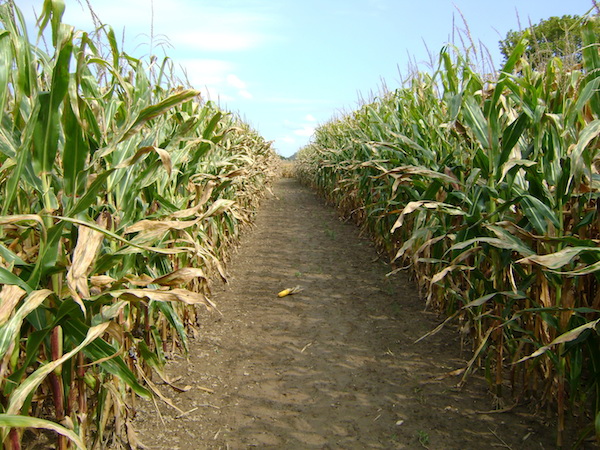
These little agricultural cells became the containers of family mythologies, overlain by a patina of sentimental emplacement—the family farm; the old homestead; the small kingdoms of rural children. Nostalgic emigrés to the city sought to recreate facsimiles according to the templates offered in developer-planned suburbs, with their bungalows and surrounding lawns.
But from the beginning, the farm lot could become a prison cell in which a man could be broken by overwork and worry; a woman by drudgery and isolation; a child by fearful discipline and the psychological damage of secrets necessary to keep up a public face to neighbors. The demons of dissolution, madness, crop failure, and economic disaster haunted all, though some more than others. These fears, and their accompanying mythologies, were condensed into a domestic tableau of failure painted in 1890 by Canadian artist, G. A. Reid (“Mortgaging the Homestead”).
But the haunting was comparative and selectively applied by the very people subject to it. Neighbor helped neighbor with barn-raising, firefighting, and the freeing of stuck implements. But neighbor also watched neighbor for signs of weakness or untrustworthiness. Farm men and women kept in their heads practical genealogies of scores of families, noting every alcoholic and every possessor of some supposedly inherited degenerative trait. In a 1920s poem, Ontario author Raymond Knister (“The Motor: A Fragment,” in After Exile, Exile Editions, 2011) described the exhilarating freedom of taking an automobile down a rural highway, but noted also the sides of the road through a farmer’s eyes:
To swoop like a bird over crossings
And the rises at the heads of farmers’ lanes,
Past farm-houses deeply over-woven:
Trees, vines, gardens and flowers;
Past the dismal unshaded farm-houses,
Keys to parched lives.
Past farms quiet and busy and sane, with weedy fronts,
Past homes of the idler, and of the man who would kill himself
With the pride of his work,
That have no weeds along the road.
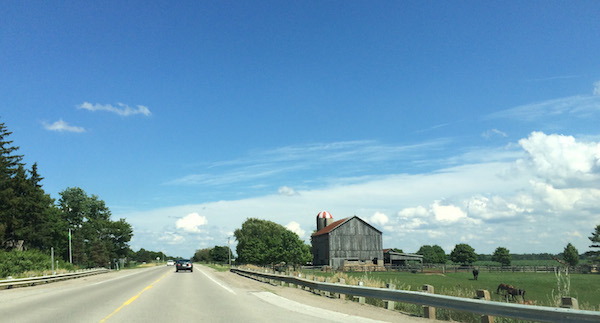
If the conquest of the wilds by reason was a more complex tale than settler culture would later imagine it to be, so private property was likewise not victorious by self-evidence alone; nor was its eventual triumph a self-manifest destiny. Other ways of imagining and living in territory—fiercely defended by several aboriginal nations and by the Metis provisional government of Louis Riel—had to be addressed, in both Canada and the US, by operations in which policing and military defeat were virtually indistinguishable.
These ventures, along with the skewed interpretation and enforcement of treaties, and the restrictive administration of Indian reservations, demanded a strengthened federal government with an extended reach, setting the stage for long disputes over sovereignty, and over local, state/provincial and federal jurisdiction, that flare to this day. The tragic expropriation of native peoples, from Jackson’s brutal expulsion of the Cherokee to Geronimo’s final stand and humiliation, and the Wounded Knee massacre, are now well-documented.
Canadians should not imagine their history to be more innocent. In Clearing the Plains: Disease, Politics of Starvation, and the Loss of Aboriginal Life (University of Regina Press, 2013), James Daschuk has unsparingly chronicled systematic brutalities north of the border.
But the settlers of the newly-lotted and railwayed plains were not unqualified beneficiaries of this process. It soon became evident that property rights were not consistently interpreted, equally guaranteed, or fairly-enforced. Railway appropriation, and property in the form of bank loans, mortgages, and industrial capital, could carry more weight than farm title, and surface ownership could be severed from mineral rights. Other rights and their legislation—for example, water rights and drainage rules—could set farmer against farmer with community-shredding results. Prices, gambled in Chicago commodity-exchanges, could be as unpredictable as the weather, and could with equal effectiveness ruin individuals, families, even communities. So could larger financial events such as the Great Panics of 1873 and 1893, which marked the intervening and following years with turmoil and hardship across the interior Plains. (The extended downturn which followed the Panic of 1873 was known as the Great Depression until the 1930s.)
A brief recovery from 1897 ended in another panic in 1907 and a now almost-forgotten depression in 1913. Farm ownership, it turned out, had the appearance of individual property, but the reality of sole and often-ineffective responsibility.
Present-day nostalgia for old-timey farm life ploughs under this precarious past. The rational description and measurement of North American land rendered it available both for tillage and for calculation of net worth. But markets and politics released many-voiced powers as frightening as the phantom hunters of the chasse d’Artur, and as confusing. There are those who would suggest that they were just as “irrational” and in more fatal ways. These forces, along with the vagaries of climate, could turn men, women, children, and the farms they struggled to establish, into ghosts sent on multigenerational quests for other species of economic quarry, sometimes equally-elusive. Some hunters captured theirs; others did not.
Rural nostalgia, combined with the urban bias of much 20-century historiography, has also obscured certain responses to these terrors. Organized farmers and farm women in both the United States and Canada responded to insecurity with valiant, if not always coherent projects to vanquish the trauma of exploitation, failure and loss. Theirs was a distinctive hope in a new continental dawn: a great co-operative commonwealth of mutual aid. That story has not yet been adequately told.
More on it here next month.

Image Credits & Permissions: Photo 1, by Aileen H. House, used by permission; Photo 2, by Henri Julien, from Wikipedia; Image 3, sketch of a southern Ontario concession and lot layout, with complaints about access and survey markers, from the author’s collection; Photo 4, by the author; Photo 5, courtesy of Eastern State Penitentiary; Photo 6, by Aileen H. House, used by permission.
Notes & Further Reading: For a study of the world Brébeuf’s rationalism was leaving behind, a world in which words played very different roles from those of a post-Cartesian era, see Michel Foucault, The Order of Things: An Archaeology of the Human Sciences (Vintage, 1994), Chapter 2, “The Prose of the World.”
Another example of the reproduction of European supernatural themes in North America is to be found in the biography of “Dr.” John Troyer, who settled near my birthplace at the end of the 18th century. His oft-retold tale of abduction to a witches’ sabbath was a staple of my childhood, and his bear-trap defense against witches was a centerpiece at the local museum. See http://www.biographi.ca/en/bio.php?id_nbr=3702.
On the commercial modernization of European agriculture and the displacements it set off, see the following:
—George Huppert, After the Black Death: A Social History of Early Modern Europe, 2nd. edition (Indiana University Press, 1998), especially chapters IV, VI, VII and XI.
—Karl Polanyi, The Great Transformation: The Political and Economic Origins of Our Time (Beacon, 2001).
The divergence of Native American and colonial concepts of ownership—and their respective ecological effects—is a story well-told in William Cronon’s Changes in the Land: Indians, Colonists, and the Ecology of New England, rev. ed. (Hill and Wang, 2003).
Candace Savage gives a superlative ecological portrait of the prairie grasslands in Prairie: A Natural History (Greystone Books / David Suzuki Foundation, 2011).
Savage’s description of Native-European encounters in the settlement of the Canadian West, in A Geography of Blood: Unearthing Memory from a Prairie Landscape (Greystone Books / David Suzuki Foundation, 2012), deserves to be read alongside Daschuk’s Clearing the Plains, referred to above.
On measurement and its historical impacts, see these:
—Jennifer Karns Alexander, The Mantra of Efficiency: From Waterwheel to Social Control. Johns Hopkins University Press, 2008.
—Douglas W. Allen, The Institutional Revolution: Measurement and the Economic Emergence of the Modern World (The University of Chicago Press, 2012).
On prison reform, prison design and the individualized management of prisoners, see Michel Foucault, Discipline and Punish: The Birth of the Prison (Vintage, 1995).
There is a vast literature describing the mental and emotional worlds made by the settlers. My highly-selective and idiosyncratic starter list would include the following:
—Willa Cather, My Ántonia (Dover, 1994)
—Willa Cather, O Pioneers! (Bantam Classics, 1989)
—Kent Haruf, Plainsong (Vintage, 2000)
—W. O. Mitchell, Who Has Seen The Wind (New Canadian Library, 2001)
—Alice Munro, The View from Castle Rock (Penguin 2010)
—Martha Ostenso, Wild Geese (New Canadian Library, 2008)
—Sinclair Ross, As For Me and My House (New Canadian Library, 2008)
—Wallace Stegner, Wolf Willow: A History, a Story, and a Memory of the Last Plains Frontier (Penguin Classics, 2000)
Image Credits & Permissions: Photo 1, by Aileen H. House, used by permission; Photo 2, by Henri Julien, from Wikipedia; Image 3, sketch of a southern Ontario concession and lot layout, with complaints about access and survey markers, from the author’s collection; Photo 4, by the author; Photo 5, courtesy of Eastern State Penitentiary Historic Site; Photos 6 and 7, by Aileen H. House, used by permission.
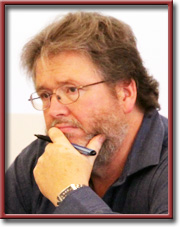
7 Comments
William Ramp
Aileen House, who took three of the photos used in this column (#’s 1, 6 and 7) has suggested another ‘further reading’ item; one I wholeheartedly endorse –
‘Blood Meridian, or the Evening Redness in the West’ (Vintage, 1992), a novel by Cormac McCarthy, draws in horrific detail on occurrences in the U.S. Southwest in the mid-nineteenth century. It gives a visceral rendering of the warfare, brutal commercial exploitation, sheer violence, and unreasoned mayhem that very often strode before the spreading edge of settlement. Murder, robbery and gang assaults, the slaughter of the buffalo, the harvest of bones (http://westernfarmpress.com/blog/buffalo-bone-fertilizer-forgotten-days-agriculture) preceded –but also strangely abetted– the new, ordered world of grid, title and law. The prospects of surveyor and farmer were enshadowed by angel’s wings; an angel of destruction.
‘Blood Meridian’ is much more than an historical novel. Those who reach its end are not the same as when they took it up. McCarthy’s prose lifts off the page to take the reader, breath constricted, hostage to glory and terror. Read the whole thing. And then, re-read, slowly and with care, the epilogue.
Elizabeth Boleman-Herring
I thought, after “The Road,” that I’d have to stop reading McCarthy: too painful. But I can see I have one more novel to read. He IS a master, but he gets under much more than one’s skin.
William Ramp
One more haunting vision. I remembered the following excerpt from Francis Parkman’s, ‘The Jesuits in North America’ (Little, Brown & co., 1879: 108-9) too late to work into this column, but could not leave it aside.
It describes a vision seen by Jean de Brébeuf; a haunting image which brings to mind the description by Dollier and Galinée of their encounter with ‘la chasse Artus.’ However, Brébeuf’s attitude toward it was considerably less dismissive:
“Demons in troops appeared before him [Brébeuf], sometimes in the guise of men, sometimes as bears, wolves, or wild-cats. He called on God, and the apparitions vanished. Death, like a skeleton, sometimes menaced him, and once, as he faced it with an unquailing eye, it fell powerless at his feet. A demon, in the form of a woman, assailed him with the temptation which beset St. Benedict among the rocks of Subiaco; but Brébeuf signed the cross, and the infernal siren melted into air. He saw the vision of a vast and gorgeous palace; and a miraculous voice assured him that such was to be the reward of those who dwelt in savage hovels for the cause of God. Angels appeared to him; and more than once St. Joseph and the Virgin were visibly present before his sight. Once, when he was among the Neutral Nation, in the winter of 1640, he beheld the ominous apparition of a great cross slowly approaching from the quarter where lay the country of the Iroquois. He told the vision to his comrades.
‘What was it like? How large was it?’ they eagerly demanded.
‘Large enough,’ replied the priest, ‘to crucify us all’.”
(Quoted in Douglas Glover, “Long Point, A Geography of the Soul,” Numéro Cinq II(4) 2011: http://numerocinqmagazine.com/2011/04/10/long-point-a-geography-of-the-soul-collected-by-douglas-glover/)
Despite training and a career in the social sciences, I’ve recently been drawn more to imagistic and literary coinage. Perhaps Parkman, the dry New Englander, felt a similar pull at times. Though he dismissed Brébeuf’s visions as matter for ‘the province of psychology’, he limns a portent here. This is a Good Friday foreshadowed: Brébeuf’s martyrdom in 1649, and the decimation and dispersal of the Wendat (Hurons) by their cultural and linguistic cousins, the Haudenosaunee (Iroquois).
Could this crucifixion motif be extended to another, wider context? The many-sided wars of the 1640’s and ‘50’s, which also destroyed the Neutrals, Petuns, and Eries, were aggravated by alliances with French or English, and by social disruption and political unrest arising from the disastrous epidemics and periods of starvation in the 1640’s. The crucifixion of the Hurons had more than a passing relation to the gathering darkness of colonial wars and settlement pressure. So did Parkman’s historical writing to the iron progress of Manifest Destiny.
Perhaps the crucifixion which appeared to Brébeuf the missionary, can be re-imagined in hindsight as an admonishment of Brébeuf the rationalist. The fixing of the continental interior to right-angled grids and its titling in legal descriptions facilitated the production of enormous wealth and resurrected for millions the prospect of new lives. It also, willingly, if not always in full consciousness, sacrificed ten thousand years of human autonomy, uncounted actual human beings, and later still, discarded industrial-age livelihoods and neighbourhoods, to a new pax Americana: Progress, Productivity, Prosperity, Rationality.
William Ramp
Just one final set of author’s comments (I promise! I promise!).
Aileen House has pointed out to me that the ‘Little House on the Prairie’ series by Laura Ingalls Wilder has a darker subtext. The Ingalls’ took up land in an area reserved, formally anyway, for the Osage. But Osage lands were in the process of being reduced to a fraction by settler encroachment, with the full knowledge of government.
Ingalls Wilder was also familiar with the shadow side of settler society, and wrote about it – financial failure, drunkenness, domestic abuse – in ‘Pioneer Girl’: http://www.theguardian.com/books/2014/aug/25/laura-ingalls-wilder-memoir-little-house-prairie?CMP=fb_gu
David J. Wishart’s ‘An Unspeakable Sadness: The Dispossession of the Nebraska Indians’ (University of Nebraska Press, 1995) gives, in meticulously-researched detail, and with telling cartography, the story of how the first peoples of Nebraska were disinherited of their own lands. A process analogous to many others, both across the plains, and globally. http://www.nebraskapress.unl.edu/product/Unspeakable-Sadness,673638.aspx
Michael Lesy’s 1973 book, ‘Wisconsin Death Trip’ (later made into a feature film), is one that ‘gets under much more than one’s skin’, as Elizabeth Boleman-Herring put it above. Working with images and news clippings from the time, Lesy gives an eerie portrayal of the dark understory of life in a small midwestern town in the 1890’s. Laconic news items and obituaries record events that would have become, in many cases, ‘no-tell’ family secrets blighting generations: madness, suicide, murder, assault, disease, failure. Also noted: the visitations of ghosts, devils, and spells. http://www.wisconsindeathtrip.com/about.html
And finally, James Belich’s massive ‘Replenishing the Earth: The Settler Revolution and the Rise of the Anglo-World, 1783-1939′ (Oxford University Press, 2009) gives a compelling history of the international migration and settlement processes that populated Australia, Canada, and the United States. Belich provides a corrective to accounts that over-emphasize European economic and administrative rationality, pointing out the wild elements and spasmodic moments in the expansion of settlement and the founding of new agricultural-commodity economies. Despite its length, it’s a rivetting narrative. http://www.history.ac.uk/reviews/review/895
George Ferzoco
This — the post as well as the comments — will bear re-reading, more than once. Among other things, I will never look at our hallway in the same way.
Pedantic note: you’re right to put ‘[sic]’ after ‘scrap’, since this seems not to be in contemporary usage. But I very strongly suspect, far from having to hand appropriate reference works dealing particularly with Scottish dialect, that ‘scrap’ is but a variant of ‘scrape’, less anyone think the writer of the primary source was somehow deficient in his use of English.
William Ramp
Weel, George Ferzoco, Ah hae ma copie o the Scots Dictionair tae haund, an yer aye richt in yer readin!
“Scrap” is indeed a legitimate Scots spelling of “scrape.” William Shand and his literate Banffshire/Aberdeenshire contemporaries were in effect almost trilingual. At home and in most business transactions, they spoke Scots — or rather, a dialect of Scots called Doric. At school, their knuckles were whacked into penning English. In their diaries and correspondence, they continued often to write English, but liberally salted with Scots terms, spellings, and phraseology.
A word to those less familiar with the languages of Scotland: Scots is not the same as Gaelic, the language of the western Highlands and islands. It’s closely related to old Northumbrian English, but has numerous loan words not only from Gaelic, but also from the various linguistic families around the North Sea. (In Shetland and Orkney, a north-Germanic language, Norn, was spoken historically.)
But noo, George, dinna be cawin Scots a “dialect” agin, and nae the Mither Tung! Or Ah’ll’ hae wirds wi ye in a Glesga back alley…
Elizabeth Boleman-Herring
Wee Georgie and Wee Billy might ALSO enjoy Graham Robb’s recent “Mapping the Lost World of the Celts: The Discovery of Middle Earth,” which has a fair bit to say about . . . Gaulish (a related linguistic minefield). I especially like the Gaulish curse tablets, which we three might find of use. :-)